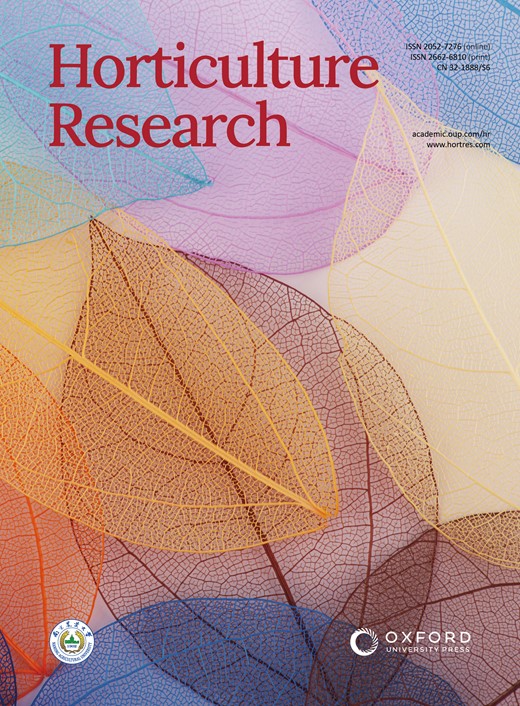Salicylic Acid Improves Chilling Tolerance via CsNPR1–CsICE1 interaction in Grafted Cucumbers
IF 8.7
1区 农林科学
Q1 Agricultural and Biological Sciences
引用次数: 0
Abstract
Salicylic acid (SA) plays a role in regulating of grafting-induced cold tolerance. However, the molecular mechanism behind it is still unknown. Here, we established that the phenylalanine ammonia-lyase (PAL) pathway-dependent elevate in SA content in grafted cucumber leaves was not only synthesized in the leaves but also transported from the roots under chilling stress. RNAi-CsPAL with low SA content as rootstock reduced SA accumulation in grafted seedling leaves while decreasing rootstock-induced cold tolerance, as evidenced by higher electrolyte leakage (EL), hydrogen peroxide (H2O2), and superoxide anion (O2·−) contents and lower expression of cold-responsive genes (CsICE1, CsDREB1A, CsDREB1B, and CsCOR47), whereas OE-CsPAL with high SA content as rootstock improved the cold tolerance of grafted plants in comparison with the wild type (WT). In addition, CsNPR1 was significantly upregulated in grafted cucumber under chilling stress, with exogenous and endogenous overexpressed SA inducing its transcriptional expression and protein stability, which exhibited higher expression in grafted plants than in self-root plants. While CsNPR1-overexpression (OE-CsNPR1) seedlings as scions were more tolerant to chilling stress than WT seedlings, CsNPR1-suppression (Anti-CsNPR1) seedlings as scions were more vulnerable to chilling stress. Notably, CsNPR1–CsICE1 interactions alleviated ROS accumulation and activated the expression of CsDREB1A, CsDREB1B, CsCOR47, CsCOR15, CsCOR413, and CsKIN1 to enhance SA-mediated chilling tolerance in grafted cucumber. Overall, our findings reveal that SA enhances chilling tolerance in grafted cucumbers via the model of the CsNPR1–CsICE1 transcriptional regulatory cascade.水杨酸通过 CsNPR1-CsICE1 相互作用提高嫁接黄瓜的耐寒性
水杨酸(SA)在调节嫁接诱导的耐寒性方面发挥作用。然而,其背后的分子机制尚不清楚。在这里,我们发现在寒冷胁迫下,嫁接黄瓜叶片中的苯丙氨酸氨解酶(PAL)途径依赖的SA含量升高不仅在叶片中合成,而且还从根部转运。以低 SA 含量的 RNAi-CsPAL 作为砧木会减少嫁接苗叶片中的 SA 积累,同时降低砧木诱导的耐寒性,这表现在较高的电解质渗漏(EL)、过氧化氢(H2O2)和超氧阴离子(O2)上、而与野生型(WT)相比,SA 含量高的 OE-CsPAL 作为砧木可提高嫁接植株的耐寒性。此外,在寒冷胁迫下,CsNPR1在嫁接黄瓜中显著上调,外源和内源过表达的SA诱导其转录表达和蛋白稳定性,其在嫁接植株中的表达高于自根植株。作为接穗的CsNPR1-overexpression(OE-CsNPR1)幼苗比WT幼苗更能承受寒冷胁迫,而作为接穗的CsNPR1-suppression(Anti-CsNPR1)幼苗则更容易受到寒冷胁迫的影响。值得注意的是,CsNPR1-CsICE1 的相互作用减轻了 ROS 的积累,并激活了 CsDREB1A、CsDREB1B、CsCOR47、CsCOR15、CsCOR413 和 CsKIN1 的表达,从而增强了嫁接黄瓜对 SA 介导的寒冷胁迫的耐受性。总之,我们的研究结果表明,SA 通过 CsNPR1-CsICE1 转录调控级联模型增强了嫁接黄瓜的耐寒性。
本文章由计算机程序翻译,如有差异,请以英文原文为准。
求助全文
约1分钟内获得全文
求助全文
来源期刊

Horticulture Research
Biochemistry, Genetics and Molecular Biology-Biochemistry
CiteScore
11.20
自引率
6.90%
发文量
367
审稿时长
20 weeks
期刊介绍:
Horticulture Research, an open access journal affiliated with Nanjing Agricultural University, has achieved the prestigious ranking of number one in the Horticulture category of the Journal Citation Reports ™ from Clarivate, 2022. As a leading publication in the field, the journal is dedicated to disseminating original research articles, comprehensive reviews, insightful perspectives, thought-provoking comments, and valuable correspondence articles and letters to the editor. Its scope encompasses all vital aspects of horticultural plants and disciplines, such as biotechnology, breeding, cellular and molecular biology, evolution, genetics, inter-species interactions, physiology, and the origination and domestication of crops.
 求助内容:
求助内容: 应助结果提醒方式:
应助结果提醒方式:


